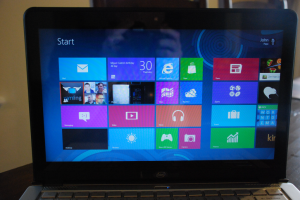I’ve been using the Intel IvyBridge Ultrabook that I received from the folks at Intel for the past few weeks. My experience with it over that time has left me extremely impressed. The array of sensors on the device are perhaps the most impressive.
From what I can tell, the machine itself is not one that we'll see in stores, but instead its simply just a model Intel used as a sample to show what OEM’s can create for Windows 8.
You can read my initial impressions of the IvyBridge Ultrabook here. This time I’ll focus on my experiences with using it over the past few weeks. First, I can’t say enough about how much I love lightweight, fast, and good looking notebooks. I bring my notebook everywhere: onsite visits, airplanes for business trips, conference presentations, and ever just around the office. So I find it crucial to have a notebook that is lightweight and powerful. This device certainly fit the bill and it looks good (come on, you know that matters)!
Speed
I am so used to powering on my laptops and having time to grab coffee or check Twitter on my phone. Not with the IvyBridge Ultrabook. This thing boots crazy fast and is ready to go practically before I get a chance to get out of my chair. I’m sure the IvyBridge i5 processor and 180 GB SSD have a lot to do with this, and I sure ain’t complaining.
I recently used it to work on some Windows 8 course material I recorded for Pluralsight. I had to load Visual Studio 2012, Powerpoint, Camtasia 8 for recording, and OneNote. I was able to open all of these very fast and record some videos with ease. This is no small feat. Visual Studio can consume some serious resources and recording videos is always a resource hog. On top of this, I was using the rotation and touch sensors extensively during the recording and it turned out great.
Touch Screen
I’ve got 1 problem with the Ultrabook: it makes me want to use touch on all of my computers. The touch experience with Windows 8 on the Intel IvyBridge Ultrabook is so good that I keep trying to use touch gestures on my non-touch computers now. Seriously! I’ll be sitting at my 3 monitors on my desk and I’ll lean forward to touch. The touch on the Ultrabook device is very fluid. Very natural feeling. Tap, hold, double tap, swipe … they all work great.
It’s worth pointing out that not all touch devices I have used perform equally. Some provide a great experience like some of the leading modern tablets and phones. Others come up as pretenders. Some are sluggish where I either have to repeat my gestures, the device can’t determine accurately what gesture I am trying to do, or they make me press so hard that my fingers hurt. All of this takes away from the touch experience. However, when touch is done right, the experience is fantastic, and that’s where the IvyBridge soars.
Windows 8 store apps can take advantage of many types of sensors including touch, accelerometer, NFC, GPS, device rotation and more (You can learn more about these available sensors here). I’ve tried some of these with some quick apps I tested, but I’m looking forward to trying more out once the apps start pouring in.
Tapping into the Sensors
Windows 8 makes it fairly simple to access a variety of sensors that a device may expose. You can access these using the Windows Sensor and Location Platform located here. You can find APIs for sensors including (but not limited to) these APIs:
- Accelerometer ( acceleration along 3 axes)
- Compass (orientation and position)
- Gyrometer (angular velocity)
- Inclinometer (angle of incline)
- LightSensor (ambient lighting)
- OrientationSensor (combines accelerometer, compass, gyrometer to get more sensitive movement)
- SimpleOrientation (orientation of the device including face up or down)
Each of these Windows 8 APIs detect changes (noted in the above list) so you can tap into the sensors. There are some obvious things we can do with these APIs by themselves, but the cool part is how you can create apps that combine many of these sensors on devices that offer multiple of them like the Intel IvyBridge Ultrabook.
My mind is already spinning on the possibilities, not just for games but for business apps. What are you going to build?
More on Sensors
My experience so far has been excellent. Its fast, good looking, extremely portable, and the most surprisingly, the sensor experience has be fantastic. I’ve never really experienced so many sensors on a single laptop sized device before, so I am planning on spending more time with the sensors over the next few weeks. It will be great to try them out with some of the apps in the Windows store. I’ll be sure to follow up with one final review at that time.
Disclosure of Material Connection: I received one or more of the products or services mentioned above for free in the hope that I would mention it on my blog. Regardless, I only recommend products or services I use personally and believe my readers will enjoy. I am disclosing this in accordance with the Federal Trade Commission’s 16 CFR, Part 255: “Guides Concerning the Use of Endorsements and Testimonials in Advertising.”






